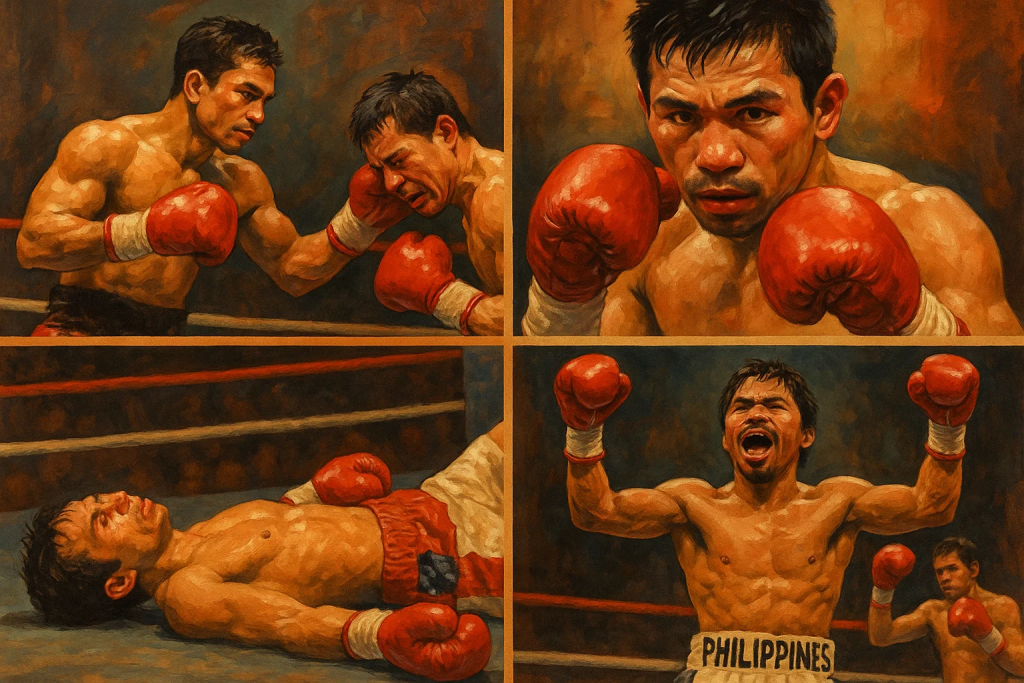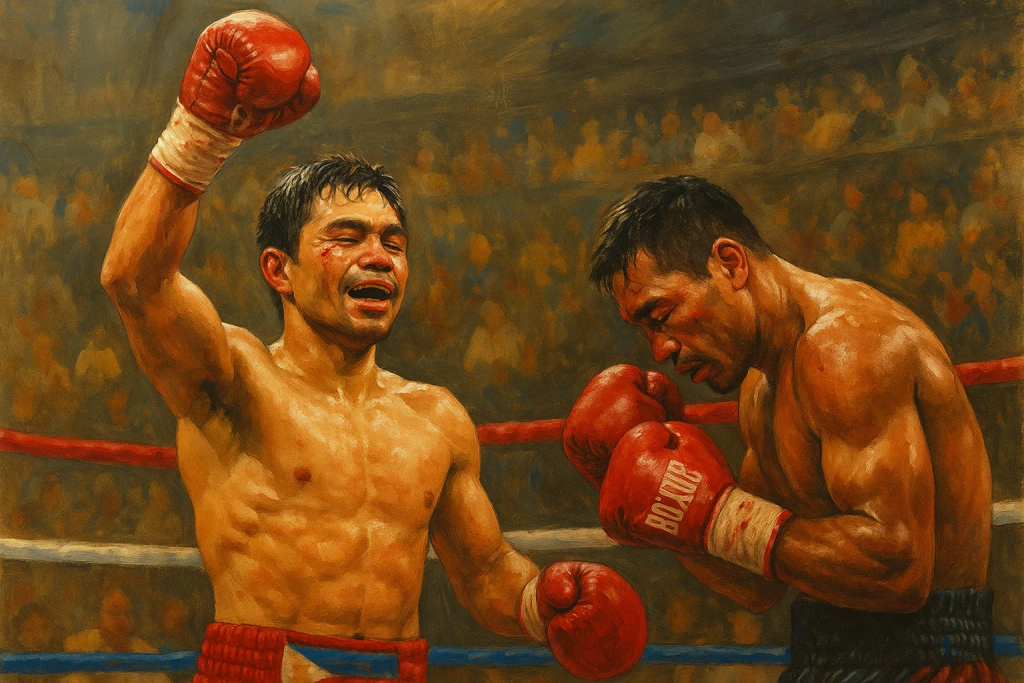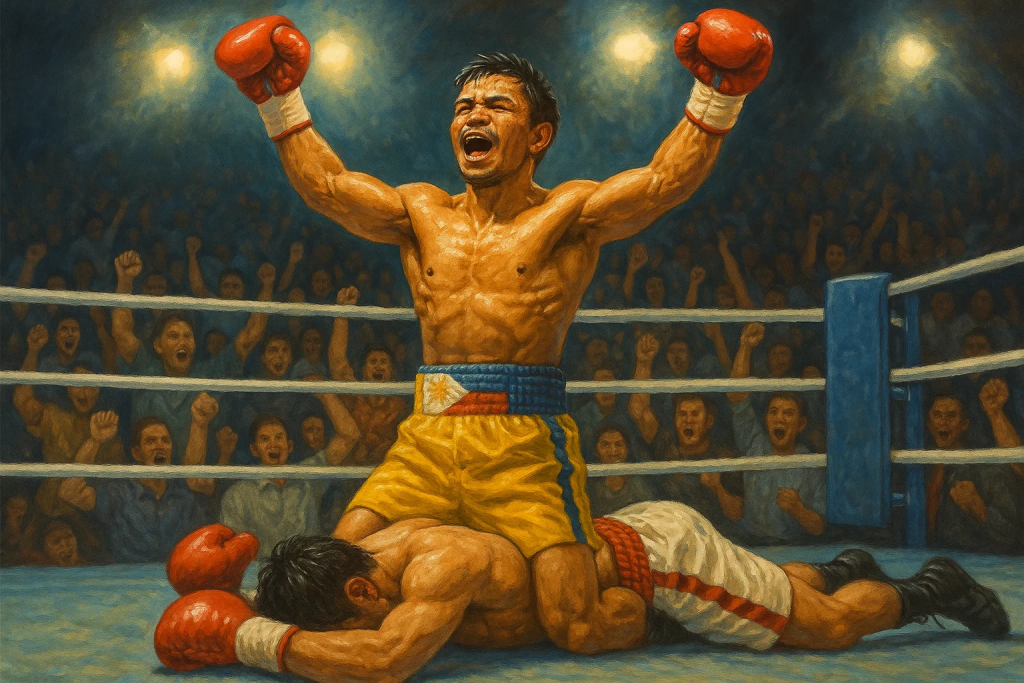Table of Contents
Why Filipino Fighters Rebound—and What Their Journeys Teach Us
Why the Philippines Loves a Comeback? In the Philippines, the boxing ring doubles as a stage where grit meets grace. From bustling barangay gyms to packed arenas and primetime broadcasts, boxing comebacks—those hard-won returns after a knockout loss, a career layoff, or a heartbreaking decision—capture the national imagination. Filipinos understand resilience. It’s woven into daily life: storms rebuilt from, opportunities carved out abroad, and dreams pursued against the odds. So when a boxer climbs the steps again after defeat, he isn’t just fighting for rankings—he’s fighting for a narrative that millions recognize as their own.
This guide explores redemption stories in Philippine rings and extracts practical frameworks: training blocks, mindset strategies, nutrition, promoter relations, and fan engagement. Along the way, you’ll find the cultural context that makes Filipino comebacks distinct—and actionable steps for coaches, amateurs, and pros who want to design their own second (or third) act.

1) The Anatomy of a Filipino Boxing Comeback
1.1 The Emotional Spark
Every return starts with a single decision: I’m not done yet. For many Filipino fighters, that spark is fed by family expectations, community pride, and a sense of unfinished business. This inner ignition must be sustainable—more than vengeance, it has to be purpose. The most consistent comebacks are anchored in:
- A compelling why: providing for family, honoring a promise, or reclaiming legacy.
- A concrete target: a domestic strap, a regional belt, or a top-15 ranking.
- A public declaration: an interview or gym post that sets social accountability in motion.
1.2 The Realities of the Road Back
Comebacks are far more complex than highlight reels suggest:
- Ring rust is real. Timing, distance, and defensive reactions degrade quickly.
- Aging curves exist—even iron chins need smarter tactics.
- Market dynamics matter. The right matchmaker can accelerate a return; the wrong one can derail it.
1.3 The Filipino Advantage: Community and Culture
The Philippines offers an intangible competitive edge: communal lift. Local gyms nurture tough sparring, coaches share ringside wisdom, and fans turn neighborhood fights into pressure cookers that harden composure. In comeback season, an arena of voices can feel like a second coach, reminding you to keep your guard up, to let your hands go, to refuse the clinch when you sense the tide turning.
2) Redemption Stories: Patterns, Not Just Personalities
(This section distills recurring patterns seen across well-known and rising Filipino fighters—without hinging on a single biography—so you can apply the lessons broadly.)
2.1 Losing the First Big Test—Then Leveling Up
A common Philippine arc: a young talent blasts through local opposition, hits a world-class gatekeeper, and falls short. The turning point comes when team and fighter analyze why:
- Was it pace (gassed by round 8)?
- Was it range (beaten to the jab)?
- Was it punch selection (head-hunting instead of body work)?
- Was it composure (abandoned game plan after a cut or knockdown)?
The redemption blueprint typically emphasizes fundamentals, defense, and ring IQ—not just conditioning or power.
2.2 Career Stall After a Layoff—Restarting the Engine
Injuries, promotional disputes, or family circumstances pause careers. The comeback starts with health baselines (orthopedic screening, mobility, eye exam), then graduated loading:
- Movement & mobility month: foot drills, joint integrity, aerobic base.
- Contact reintroduction: light touch sparring, tech sparring, controlled rounds.
- Pressure acclimation: scenarios (cut over eye; fighting backing up; late-round surges).
- Brand rebuild: gym content, local press, community exhibitions to regain visibility.
2.3 Late-Career Renaissance—Winning With Wisdom
A seasoned Filipino fighter may drop down a division, move up, or reinvent his style. He’ll use feints, timing, clinch craft, and body shots to offset lost hand speed. Camps are shorter but smarter, with recovery blocks planned like title rounds. The lesson: longevity is an IQ game.
3) The “7-Pillar Comeback Framework” for Philippine Rings
To turn stories into systems, use these seven pillars—modeled after successful returns in Filipino boxing culture.
Pillar 1: Audit (Health, Skills, Lifestyle)
- Medical: EKG, bloodwork, eye health, concussion history, joint assessment.
- Skill: film review vs. elite opponents; defense metrics (slips per round, clinch breaks).
- Lifestyle: sleep, stress, travel, nutrition.
Deliverable: a one-page audit with three fix-first priorities.
Pillar 2: Game Model (How You Win Now)
- Define your A-Game (e.g., pressure body-puncher; southpaw counter-puncher).
- Map your win conditions by round clusters: R1–3 (data gathering), R4–7 (body investment), R8–12 (sustained pressure or counter traps).
- Eliminate “grey zone” tactics that don’t fit the model.
Pillar 3: Camp Architecture (8–12 Weeks)
- Base (Weeks 1–3): aerobic engine, hip/ankle mobility, defensive drills.
- Build (Weeks 4–6): heavy bag density, spar volume, anaerobic intervals.
- Peak (Weeks 7–9): opponent-specific sparring, situational rounds, mitt patterns.
- Taper (Weeks 10–12): intensity up, volume down; timing and reflex priorities.
Pillar 4: Strength & Conditioning (Damage Output + Durability)
- Lower-body power: loaded jumps, sled pushes for drive on straight shots.
- Rotational force: med-ball throws, landmine punches for hook authority.
- Neck/Upper-back: isometrics for punch absorption and clinch control.
- Energy systems: 3:1 work-to-rest sprints mimicking exchange bursts.
Pillar 5: Fight IQ Upgrades (Film & Situational Rounds)
- Film lab: learn trigger patterns—opponent jabs after feints; dips after lead hooks.
- Rounds with constraints: “You cannot throw a right hand for 2 rounds” to sharpen jabs/feints.
- Ref & cut-man simulation: train responses to warnings, cuts, glove checks.
Pillar 6: Brand & Business (Tickets, TV, Trust)
- Narrative: frame the comeback (family, faith, unfinished goals).
- Local media & gyms: open workouts, barrio meet-and-greets, school visits.
- Promoter alignment: clarity on step-up timeline (2 tune-ups → regional title eliminator).
Pillar 7: Support Systems (Mind, Money, Mentors)
- Sports psych: composure scripts, breath work, “between-rounds reset” cues.
- Financial plan: emergency fund for camp hiccups.
- Mentors: retired champs, national trainers, and cut-men with big-fight reps.
4) Training Micro-Cycles: A Coach’s Calendar for the Return
Sample 10-Week Camp (Philippine Climate & Travel Considered)
Weeks 1–2 (Reset & Foundation)
- Mornings: 40-60 min roadwork (aerobic), stride drills; shadowboxing with mirrors.
- Midday: mobility flow (hips/ankles/thoracic spine).
- Evenings: defensive ladders, jab ladders, double-end bag for rhythm.
Weeks 3–4 (Volume & Contact)
- 4–6 rounds light tech sparring (touch only), strict defense scoring.
- Heavy bag pyramids (3–5–7–5–3 minutes) to build punch economy.
- Strength: unilateral squats, RDLs, neck isometrics, scapular rows.
Weeks 5–6 (Anaerobic Load & Specifics)
- 6–8 rounds live sparring (escalating intensity).
- Midweek hill sprints (10–12 reps @ 12–15 sec).
- Tactical mitts: body shot sequencing, angle exits, tie-up breaks.
Week 7 (Simulation)
- Two full fight simulations with cornerman timing, referee breaks, glove checks.
- Film same day; corrections next morning—repeat.
Week 8 (Sharpen & Publicity)
- Reduce spar rounds; increase mitt speed & timing.
- Open workout; local radio/online hits; fan Q&A at the gym.
Week 9 (Taper & Confidence)
- Short, crisp sessions; fast feet; heavy bag finishes (30-on/30-off x 10).
- Work cut scenarios; practice “calm starts” first 30 seconds of each round.
Fight Week (Week 10)
- Travel buffers: arrive 2–3 days early to adapt.
- Glove & wrap check routines; visualization of ring walk, corner stool cues.
- Media day: keep it tight; protect energy.
5) Technical Themes in Filipino Comebacks
5.1 Body Work as the Long Game
Filipino boxing is famous for investing downstairs. A comeback fighter may not out-speed elite youths, but he can wear them down: left hook to the liver, right uppercut after clinch breaks, jabs to the solar plexus. Over 8–12 rounds, body work equalizes speed disparities.
5.2 Footwork First
Before power punches return, foot positions must return. Emphasize:
- Outside foot wins (especially vs. opposite stance).
- Exit lanes after 2–3 punch combos.
- Trap setting: feint a step inside to draw the jab, counter over the top.
5.3 Defense You Can Count
Trackables matter. In sparring, score:
- Clean slips per round
- Successful parries
- Clinches won (establishing underhooks, spinning out)
If these metrics trend up, confidence follows.
6) Nutrition & Recovery for the Second Act
6.1 Weight-Cut Wisdom
- Choose your weight class by walk-around weight and camp stress.
- Slow cut (0.5–1.0% body weight per week) beats crash diets.
- Sodium and water manipulation only in the final 48–72 hours—under pro guidance.
6.2 Filipino Plate, Fighter Plate
A practical template rooted in local food:
- Carbs: steamed rice or kamote (sweet potato) for roadwork fuel.
- Protein: chicken adobo (lean cuts), fish (bangus, tilapia), eggs.
- Veg & fruit: malunggay (moringa), ampalaya (bitter gourd), bananas (potassium).
- Hydration: water + pinch of salt + calamansi for vitamin C and palatability.
6.3 Recovery Habits That Add Rounds
- Siesta power: 20–40 min naps after midday sessions.
- Blue-light hygiene: phones off 60 minutes pre-sleep.
- Cheap cryotherapy: cool showers post-evening workout if ice baths aren’t practical.
The Influence of Amazing American Trainers on Filipino Boxing

7) How Philippine Fans, Media, and Promoters Shape the Comeback
7.1 Fans as Force Multipliers
Filipino fans are storytellers—they make narratives stick. A humble vlog from a mountain road run can travel farther than a glossy promo. Use:
- Weekly training diaries (3–5 min clips)
- Gym-level meetups (free pads for kids; selfies, signatures)
- Community causes (gloves to public schools; anti-bullying talks)
7.2 Promoter & Network Alignment
- Lock a two-fight plan: a measured return, then a credible test.
- Align on venue (home crowd advantage), card position, and TV windows (primetime in Manila or provincial hubs).
- Negotiate rematch clauses carefully—comeback leverage climbs after a good win.
7.3 Storytelling that Converts Casuals
Headlines that perform:
- “From Jeepney Conductor to Contender: ___’s Second Shot”
- “Back from the Brink: The Body-Shot Rebuild of ___”
- “New Tricks, Old Fire: How ___ Learned to Rest and Strike”
8) Risk Management: Choosing the Right Opponent
8.1 The Tune-Up Isn’t a Throwaway
Select a fighter who tests specific repairs—if your issue was southpaws, don’t face another orthdox gatekeeper first. Control variables:
- Travel & climate similar to your home base.
- Judging familiarity: where close fights are scored fairly and predictably.
- Style exposure: avoid awkward spoilers in fight #1 of the comeback.
8.2 The Credibility Leap
Fight #2 or #3 should carry regional stakes or top-15 implications. Prepare for:
- Different gloves/commission rules
- More stringent drug testing
- Bigger rings (which affect pressure fighters)
9) What Gyms and Amateur Programs Can Copy Tomorrow
- Install “Redemption Rounds” twice a week: the fighter starts the round “down by two” in the coach’s scoring—he must win late, smart.
- Defense-only days: the boxer may only score points off counters and slips.
- Community sparring code: hard to the body, light to the head; focus on ring craft, not gym wars.
- Post-spar debriefs: 5 minutes, three bullet points: what worked, what failed, what to drill tomorrow.
10) A Short List of Underrated Comeback Indicators
- You can re-find your jab in under 30 seconds after getting clipped.
- You keep your shape when tired—elbows in, chin down, eyes clear.
- You land to the body even when head shots miss—a mature shot selection.
- You accept clinches wisely—to buy seconds, not to hide.
11) A Sample Corner Script for Comeback Fights
- Between Rounds 1–2: “Range first. Let him show the right hand. Jab chest, step left.”
- Between Rounds 4–5: “Body is ready—hook liver after the uppercut. Don’t admire the work.”
- Between Rounds 8–9: “Breathe: four count in, four out. You’re up; no hero ball. Touch, touch, two to the ribs, exit.”
These phrases are short, actionable, and calming—perfect for high-noise Philippine venues.
12) Story Endings the Philippines Loves (and You Can Aim For)
- The “Split Decision Silence”: when a narrow win triggers stunned quiet before eruption—proof of composed finishing.
- The “Body-Shot Fold”: a delayed reaction KO from liver hooks, built over 9 rounds of investment.
- The “Old-Man Trick”: a veteran turns an opponent with shoulder pressure and wins the last three rounds decisively.
Each ending reflects core Filipino boxing values: patience, craft, and heart.
13) Common Mistakes That Derail Redemption—and How to Avoid Them
- Crash Camps: compressing 12 weeks into 6. Fix: start with health audits and realistic dates.
- Sparring Wars: chasing gym clout over clean technique. Fix: controlled intensity; count defense wins.
- Narrative Overload: promising belts before proving form. Fix: one opponent at a time; let performances sell the story.
- Ignoring Finances: borrowing to fund camp without a plan B. Fix: sponsor tiers, fan merch, gym seminars to offset costs.
- Style Drift: abandoning the A-Game mid-fight. Fix: corner scripts and “if-then” plans rehearsed in sparring.
14) How Fans Can Power a Comeback (Yes, You)
- Subscribe and share training updates; algorithm boosts convert to sponsor interest.
- Buy early-bird tickets—guaranteed gate revenue helps secure TV slots.
- Be positive but real on fight week; save critiques for post-fight thoughtful feedback.
- Support the gym by attending open workouts; bring a friend who’s never watched boxing live.

Final Bell
Redemption in Philippine rings isn’t a fairy tale—it’s a framework. Audit honestly, train deliberately, tell your story with humility, and let the rounds stack truth on your side. The Philippines will show up; the ring will tell the rest. When the bell sounds and the lights burn hot, remember: comebacks here aren’t just about fighters—they’re about all of us who refuse to stay down.
Join the Movement
If these redemption stories in Philippine rings inspired you, do three things right now:
- Share this article with a Filipino boxing fan, coach, or gym owner who believes in second chances.
- Comment with the top hurdle you (or your fighter) face—ring rust, weight cuts, or opponent selection—and we’ll reply with a tailored drill or micro-cycle.
- Subscribe to our newsletter for monthly comeback blueprints: camp templates, corner scripts, and community spotlights from gyms across the archipelago.
Frequently Asked Questions (FAQ)
1) How long should a proper boxing comeback camp last?
Most successful returns use 8–12 weeks, segmented into base, build, peak, and taper. Older fighters may prefer shorter, smarter camps (9–10 weeks) with more recovery baked in.
2) What’s the fastest way to reduce ring rust?
Reintroduce timing and distance safely: double-end bag drills, tech sparring, and situational rounds (you must circle left only; you must counter off the jab). Track defensive actions (slips, parries, clinch breaks) so progress is measurable.
3) How do Filipino fighters balance power and durability during comebacks?
They prioritize lower-body power (for drive) and neck/upper-back isometrics (for impact tolerance), then pair it with body-punching game plans that win late rounds without reckless exchanges.
4) What role do Filipino fans play in a boxer’s return?
A huge one. Community support—from barangay gyms to national TV—creates momentum for sponsorships, tune-up bouts, and bigger venues. Fan energy in Philippine arenas improves composure and can swing close rounds psychologically.
5) How should a comeback fighter choose opponents?
Start with a tune-up that tests specific repairs (e.g., a southpaw if that’s a gap), then move to a credibility leap with regional stakes. Control variables: venue, travel, judging reputation, glove brand, and ring size.
